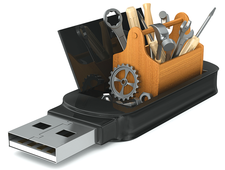Creating multiboot-capable USB sticks
Many Boots

A USB stick holding all the distributions you need can be a useful mobile toolbox. This month we explore three tools for creating multiboot-capable memory sticks.
Live boot has been part of the Linux scene for many years. The idea behind live boot is simple but very powerful: Carry the operating system with you wherever you go, and when you need it, plug it in and boot to it. Live systems let you test out an operating system before you install, which is why several common Linux distros offer pre-built live DVD images. Perhaps the most famous use for Live systems is troubleshooting. If a hard drive failure or a corrupt configuration file prevents the installed system from booting, you can boot to a live disc and start searching for the source of the trouble. Distros such as Knoppix and SystemRescueCd became famous as tools for system administrators to carry with them when called to rescue failed computers.
Old-school live systems traveled around on a CD or DVD – typically read-only media, which was a limitation on their suitability for everyday use. In the age of USB sticks, live systems have become more flexible. Support for persistence means you can customize the system in ways that were not possible with the older generation. USB sticks have also eliminated the strict size limitations that affect CDs and DVDs. USB sticks come in an assortment of sizes, and some are bigger than hard drives were in the not-so-distant past.
The large size and flexibility of USB sticks has led to another important innovation in live Linux. The first USB-based live systems were modeled on the previous CD/DVD model. You burned a system image to the stick, then started the system with the disc in place to boot the image. The best of the new live boot tools take the technology to another level. These tools basically load a boot manager onto the USB stick, then let you copy multiple system images onto the disc. You can therefore boot multiple operating systems from the same USB stick.
[...]
Buy this article as PDF
(incl. VAT)
